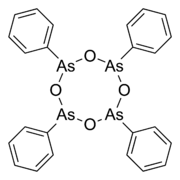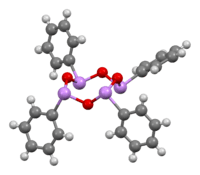Phenylarsine oxide
Phenylarsine oxide (PAO or PhAsO) is an organometallic compound with the empirical formula C6H5AsO. It contains a phenyl group and an oxygen atom both bonded to an arsenic atom.
| |||
| Names | |||
|---|---|---|---|
| IUPAC name
Oxo(phenyl)arsine | |||
| Other names
Phenyl arsenoxide; Oxo(phenyl)arsane | |||
| Identifiers | |||
3D model (JSmol) |
|||
| ChEBI | |||
| ChEMBL | |||
| ChemSpider | |||
| ECHA InfoCard | 100.010.251 | ||
| EC Number |
| ||
PubChem CID |
|||
| UNII | |||
CompTox Dashboard (EPA) |
|||
| |||
| |||
| Properties | |||
| C6H5AsO | |||
| Molar mass | 168.027 g·mol−1 | ||
| Hazards | |||
| GHS pictograms |   | ||
| GHS Signal word | Danger | ||
GHS hazard statements |
H301, H331, H400, H410 | ||
| P261, P264, P270, P271, P273, P301+310, P304+340, P311, P321, P330, P391, P403+233, P405, P501 | |||
Except where otherwise noted, data are given for materials in their standard state (at 25 °C [77 °F], 100 kPa). | |||
| Infobox references | |||
Structure
Despite its simple empirical formula, phenylarsine oxide does not contain an As=O double bond. In common with other compounds with the general formula RAsO, PhAsO forms a cyclic oligomer.[1] A range of ring sizes are possible, but PhAsO crystallizes as the tetramer, cyclo-(PhAsO)4.[2] RAsO compounds form these species because for heavy elements such as arsenic, two single bonds to oxygen are more stable than one double bond; see double bond rule for details.
Use in biochemical research
The arsenic atom in PAO has a high affinity for the sulfur atom of thiols in organic compounds, in particular, forming stable complexes with vicinal cysteine residues in protein structures. This effect makes it useful for studying ligand–receptor binding[3][4] This binding affinity also makes PAO useful for affinity chromatography by immobilizing it on a resin. It has a high selectivity for structures with vicinal cysteines rather than single cysteine residues[5] or cystine (a disulfide-bridged pair of cysteine residues).[6]
Use in wastewater analysis
Phenylarsine oxide is a reducing agent that is stable in water. As such, solutions of it can be used in iodometric methods for the determination of residual chlorine (Cl+) in wastewaters.[7] The accuracy of these methods is enough that the residual chlorine can often be detected to low ppm levels.
References
- Greenwood, Norman N.; Earnshaw, Alan (1997). Chemistry of the Elements (2nd ed.). Butterworth-Heinemann. p. 594. ISBN 978-0-08-037941-8.
- Müller, I. M.; Mühle, J. (1999). "Struktur und Koordinationsverhalten des sterisch anspruchsvollen Phenylcycloarsoxans". Z. anorg. allg. Chem. 625 (2): 336–340. doi:10.1002/(SICI)1521-3749(199902)625:2<336::AID-ZAAC336>3.0.CO;2-6.
- Verspohl, EJ (2006). "Effect of PAO (phenylarsine oxide) on the inhibitory effect of insulin and IGF-1 on insulin release from INS-1 cells". Endocrine Journal. 53 (1): 21–26. doi:10.1507/endocrj.53.21. PMID 16543668.
- Gerhard, R; John, H; Aktories, K; Just, I (2003). "Thiol-modifying phenylarsine oxide inhibits guanine nucleotide binding of Rho but not of Rac GTPases". Mol. Pharmacol. 63 (6): 1349–1355. doi:10.1124/mol.63.6.1349. PMID 12761345.
- Shi, W; Dong, J; Scott, RA; Ksenzenko, MY; Rosen, BP (1996). "The role of arsenic-thiol interactions in metalloregulation of the ars operon". J Biol Chem. 271 (16): 9291–9297. doi:10.1074/jbc.271.16.9291. PMID 8621591.
- Foley, TD; Stredny, CM; Coppa, TM; Gubbiotti, MA (2010). "An improved phenylarsine oxide-affinity method identifies triose phosphate isomerase as a candidate redox receptor protein". Neurochem. Res. 35 (2): 306–314. doi:10.1007/s11064-009-0056-z. PMID 19731017.
- Standard methods for the examination of water and wastewater. Rice, Eugene W., Bridgewater, Laura., American Public Health Association., American Water Works Association., Water Environment Federation. (22nd 2012 ed.). Washington, D.C.: American Public Health Association. 2012. pp. 4-62–4-63. ISBN 9780875530130. OCLC 774418704.CS1 maint: others (link)

